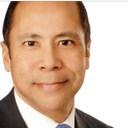Hi, I have performed many facial shaping procedures, including Chin Augmentation with dermal fillers or silastic chin implants, for over 30 years. From the photo, your chin is very weak. When the chin is weak, this creates an imbalance making the nose appear larger, the mid face top heavy, the lower face looks short, de-emphasizes the lips and allows early formation of a "double chin".


